Reflecting a demographic shift, 109 U.S. counties have become majority nonwhite since 2000
In the United States, the white share of the population is declining as Hispanic, Asian and black populations grow. But the shift to a more diverse nation is happening more quickly in some places than in others.
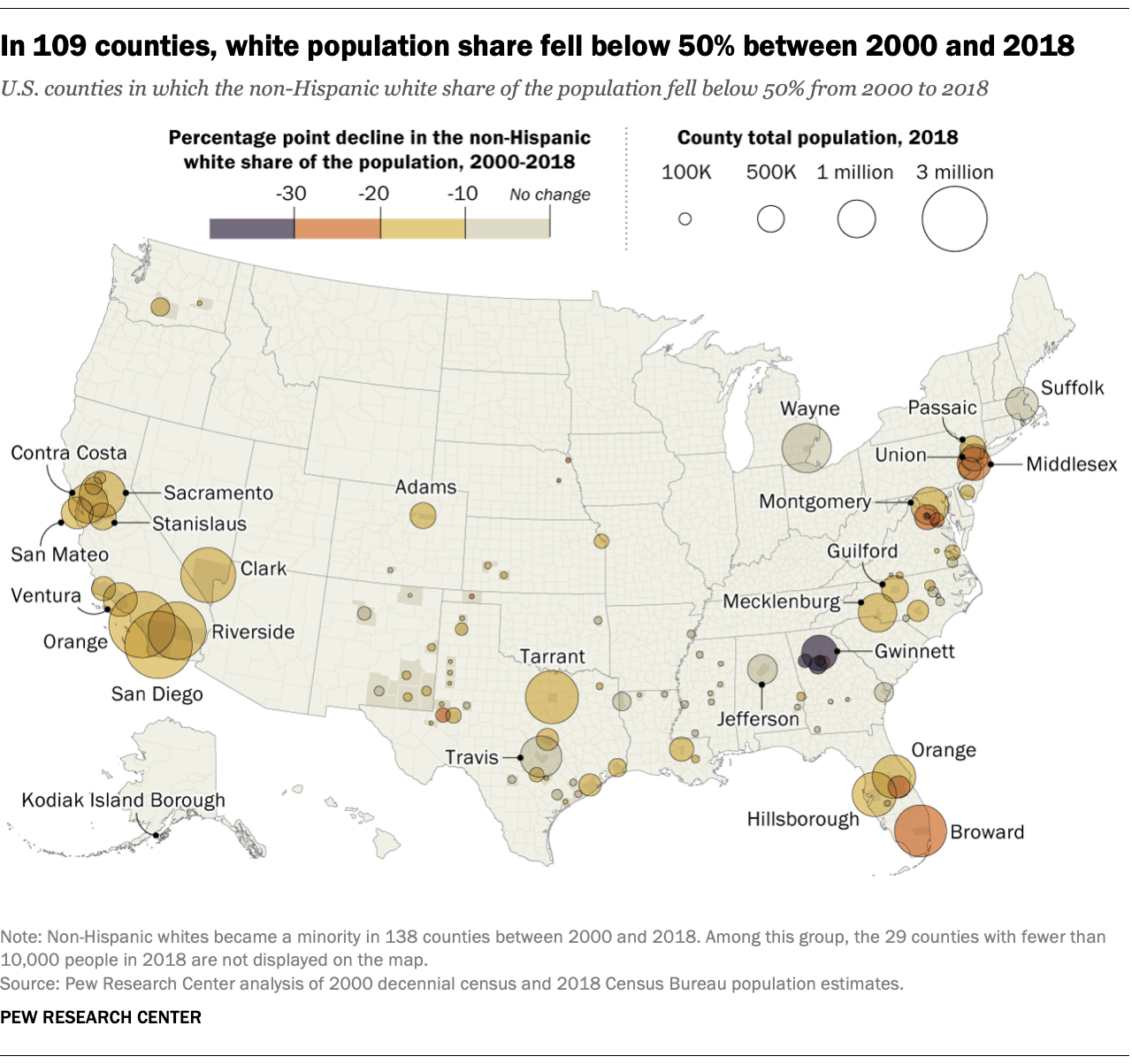
From 2000 to 2018, 109 counties in 22 states, from California to Kansas to North Carolina, went from majority white to majority nonwhite – that is, counties where non-Hispanic whites are no longer the majority, according to a Pew Research Center analysis of Census Bureau data. (Our analysis includes only counties with a minimum population of 10,000 in 2018. These counties represent 77% of the nation’s 3,142 counties and include 99% of the U.S. population.)
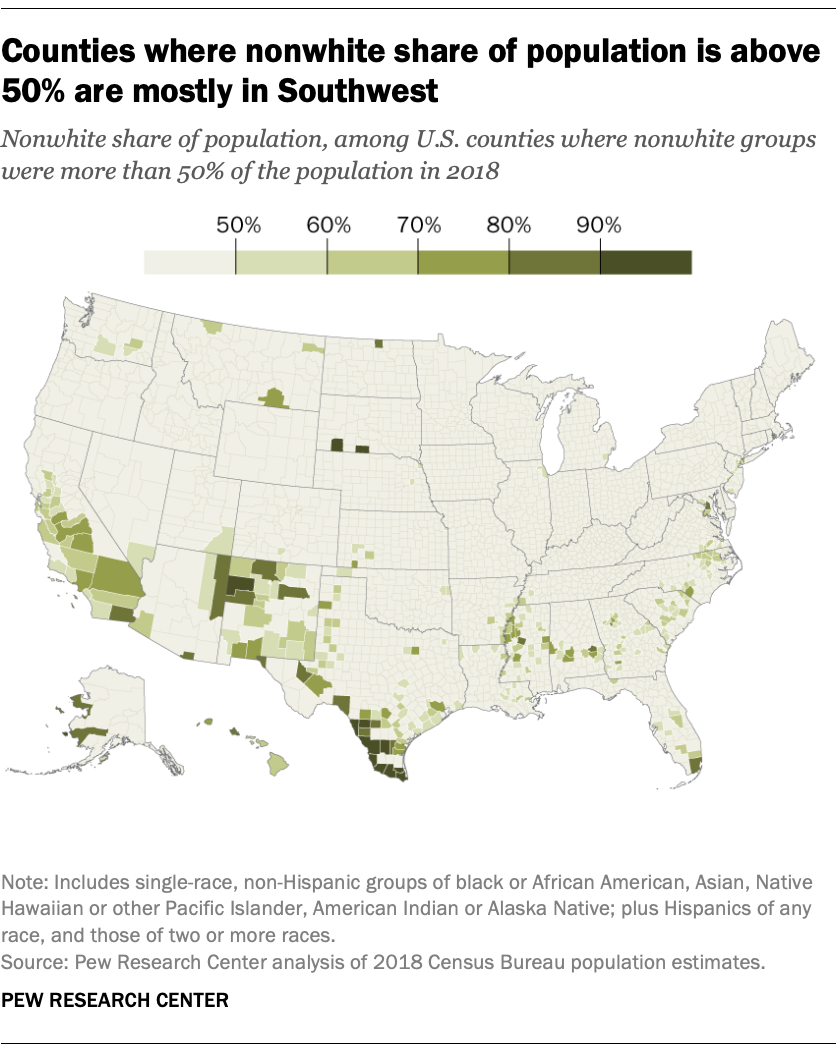 Overall, 293 U.S. counties were majority nonwhite in 2018. Most of these counties are concentrated in California, the South and on the East Coast, with few in the country’s middle section. In addition, several majority white counties with large populations may flip in coming years. Fairfax County, Virginia (total of 1.2 million), Pima County, Arizona (1 million), Milwaukee County, Wisconsin (948,000) and Cobb County, Georgia (757,000) all had populations that were less than 52% white.
Overall, 293 U.S. counties were majority nonwhite in 2018. Most of these counties are concentrated in California, the South and on the East Coast, with few in the country’s middle section. In addition, several majority white counties with large populations may flip in coming years. Fairfax County, Virginia (total of 1.2 million), Pima County, Arizona (1 million), Milwaukee County, Wisconsin (948,000) and Cobb County, Georgia (757,000) all had populations that were less than 52% white.
In 21 of the 25 biggest U.S. counties by population, nonwhite groups together make up more than half of residents. Eight of these counties were majority white in 2000 but are no longer: San Diego, Orange, Riverside and Sacramento (all in California), plus Clark (Nevada), Broward (Florida), Tarrant (Texas) and Wayne (Michigan). Hispanics were the largest nonwhite population in all of these eight counties except Wayne – which contains Detroit – where the black population was the largest nonwhite group. (In Broward County, Hispanic and black residents made up similar shares of the population at 30% and 28%, respectively.)
As the nation’s racial and ethnic diversity grows, whites remain the single largest racial or ethnic group in the U.S. when looking at the country as a whole, accounting for 60% of all Americans. The four largest U.S. counties that had majority white populations in 2018 were Maricopa (Arizona), King (Washington), Middlesex (Massachusetts) and Palm Beach (Florida).
Another way to highlight the nation’s changing demographics is to look at how many counties shifted the opposite way. From 2000 to 2018, just two counties went from minority white to majority white: Calhoun County in South Carolina and West Feliciana Parish in Louisiana, each with relatively small populations of about 15,000.
Among the 109 counties that between 2000 and 2018 shifted from majority white to majority nonwhite, 26 were at least 60% white in 2000. Counties in Georgia stand out for having five of the 10 biggest percentage point swings in their white population share. (These 10 counties also had the largest percentage point drop among all U.S. counties on this measure.)
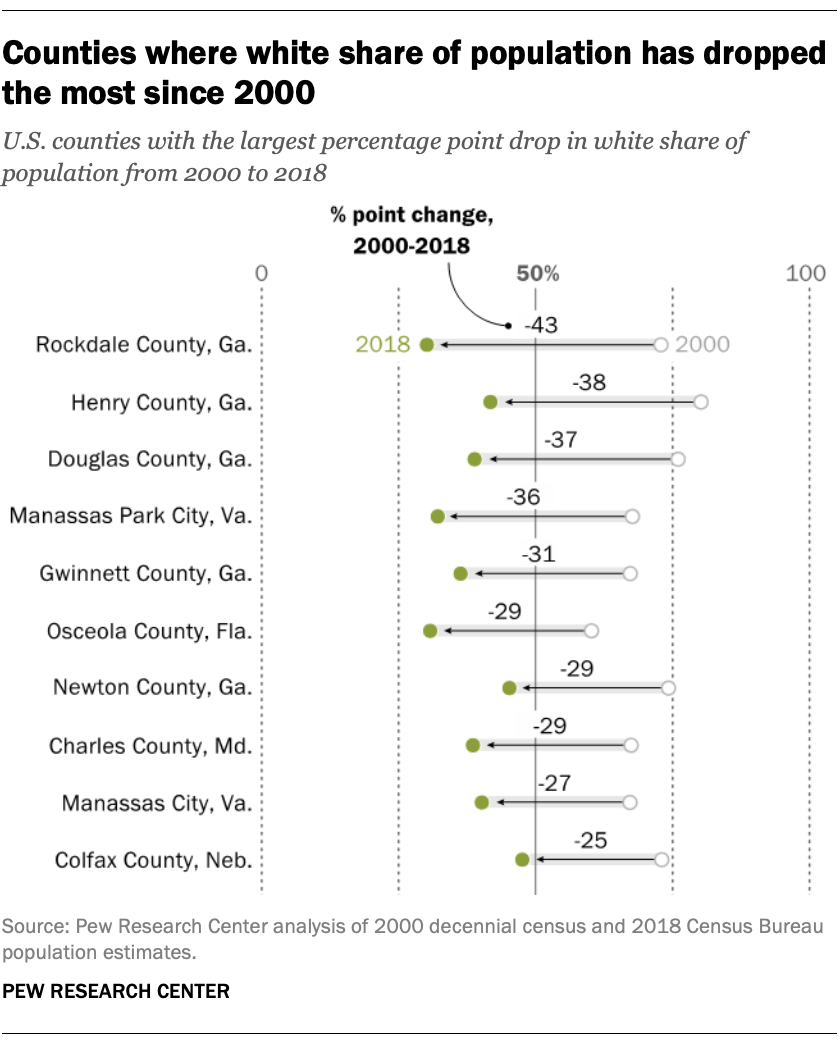 Gwinnett County, near Atlanta, was largest in overall population (928,000) among these top 10. Its population dropped from 67% white in 2000 to 36% in 2018. Rockdale, home to 91,000 and also near Atlanta, had the biggest percentage point swing of the top 10 counties on this measure, falling from 73% white to 30% during the same time period.
Gwinnett County, near Atlanta, was largest in overall population (928,000) among these top 10. Its population dropped from 67% white in 2000 to 36% in 2018. Rockdale, home to 91,000 and also near Atlanta, had the biggest percentage point swing of the top 10 counties on this measure, falling from 73% white to 30% during the same time period.
This trend stems from a flat or declining number of white Americans in each of these five Georgia counties (Henry, Douglas and Newton are the other three), combined with a large and growing black population and a smaller Hispanic population that is also increasing in number. (In recent decades, many black Americans have moved to the Atlanta area from Northern states as part of a return migration to the South.)
The future racial and ethnic composition of the U.S. has been a subject of debate, due in part to the growing number of Americans with varied backgrounds – and how these Americans identify themselves. The number of multiracial Americans is rising, for example, and in a recent Pew Research Center survey, about half of U.S. Hispanic adults identified their race as white.
Correction: The chart “Counties where nonwhite share of population is above 50% are mostly in Southwest” has been updated to correct the color of seven counties.
Note: This is an update to a post originally published April 8, 2015.
For a closer look at counties that recently flipped, see the sortable table below:
U.S. counties where white share of population has dropped below 50% since 2000
Note: County list includes parishes (Louisiana) and a borough (Alaska).
Source: Pew Research Center analysis of 2000 decennial census and 2018 Census Bureau population estimates.
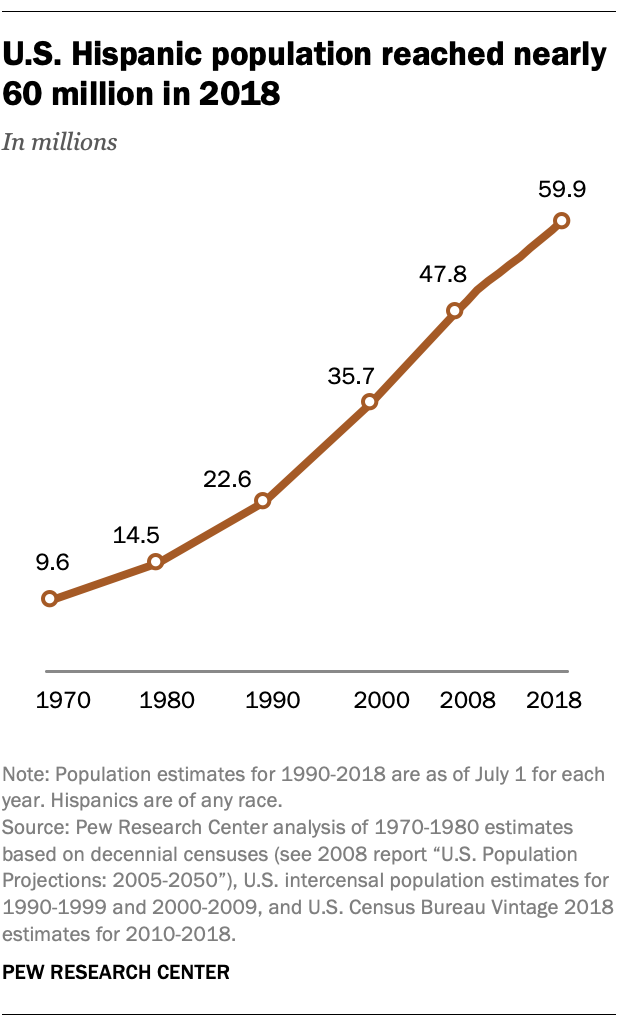 The U.S. Hispanic population reached a record 59.9 million in 2018, up 1.2 million over the previous year and up from 47.8 million in 2008, according to newly released U.S. Census Bureau population estimates. Over the past decade, however, population growth among Hispanics has slowed as the annual number of births to Hispanic women has declined and immigration has decreased, particularly from Mexico.
The U.S. Hispanic population reached a record 59.9 million in 2018, up 1.2 million over the previous year and up from 47.8 million in 2008, according to newly released U.S. Census Bureau population estimates. Over the past decade, however, population growth among Hispanics has slowed as the annual number of births to Hispanic women has declined and immigration has decreased, particularly from Mexico.
Source: Pew Research Center analysis of 2000 decennial census and 2018 Census Bureau population estimates.
U.S. Hispanic population reached new high in 2018, but growth has slowed
 The U.S. Hispanic population reached a record 59.9 million in 2018, up 1.2 million over the previous year and up from 47.8 million in 2008, according to newly released U.S. Census Bureau population estimates. Over the past decade, however, population growth among Hispanics has slowed as the annual number of births to Hispanic women has declined and immigration has decreased, particularly from Mexico.
The U.S. Hispanic population reached a record 59.9 million in 2018, up 1.2 million over the previous year and up from 47.8 million in 2008, according to newly released U.S. Census Bureau population estimates. Over the past decade, however, population growth among Hispanics has slowed as the annual number of births to Hispanic women has declined and immigration has decreased, particularly from Mexico.
Even so, Latinos remain an important part of the nation’s overall demographic story. Between 2008 and 2018, the Latino share of the total U.S. population increased from 16% to 18%. Latinos accounted for about half (52%) of all U.S. population growth over this period.
Here are some key facts about how the nation’s Latino population has changed over the past decade:
1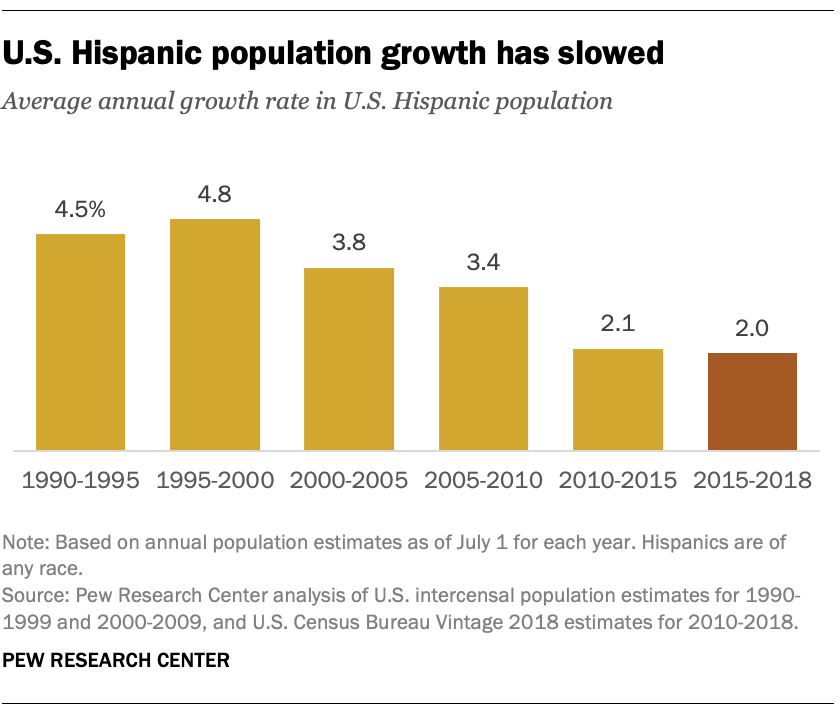 Population growth among U.S. Hispanics has slowed since the 2000s. From 2005 to 2010, the nation’s Hispanic population grew by an average of 3.4% per year, but this rate has declined to 2.0% a year since then. Even so, population growth among Hispanics continues to outpace that of some other groups. The white population saw negligible growth between 2015 and 2018, while the black population had annual average growth of less than 1% over the same period. Only Asian Americans have seen faster population growth than Hispanics, with a 2.8% growth rate between 2015 and 2018. (All racial groups are single race, non-Hispanic.)
Population growth among U.S. Hispanics has slowed since the 2000s. From 2005 to 2010, the nation’s Hispanic population grew by an average of 3.4% per year, but this rate has declined to 2.0% a year since then. Even so, population growth among Hispanics continues to outpace that of some other groups. The white population saw negligible growth between 2015 and 2018, while the black population had annual average growth of less than 1% over the same period. Only Asian Americans have seen faster population growth than Hispanics, with a 2.8% growth rate between 2015 and 2018. (All racial groups are single race, non-Hispanic.)
 Population growth among U.S. Hispanics has slowed since the 2000s. From 2005 to 2010, the nation’s Hispanic population grew by an average of 3.4% per year, but this rate has declined to 2.0% a year since then. Even so, population growth among Hispanics continues to outpace that of some other groups. The white population saw negligible growth between 2015 and 2018, while the black population had annual average growth of less than 1% over the same period. Only Asian Americans have seen faster population growth than Hispanics, with a 2.8% growth rate between 2015 and 2018. (All racial groups are single race, non-Hispanic.)
Population growth among U.S. Hispanics has slowed since the 2000s. From 2005 to 2010, the nation’s Hispanic population grew by an average of 3.4% per year, but this rate has declined to 2.0% a year since then. Even so, population growth among Hispanics continues to outpace that of some other groups. The white population saw negligible growth between 2015 and 2018, while the black population had annual average growth of less than 1% over the same period. Only Asian Americans have seen faster population growth than Hispanics, with a 2.8% growth rate between 2015 and 2018. (All racial groups are single race, non-Hispanic.)
2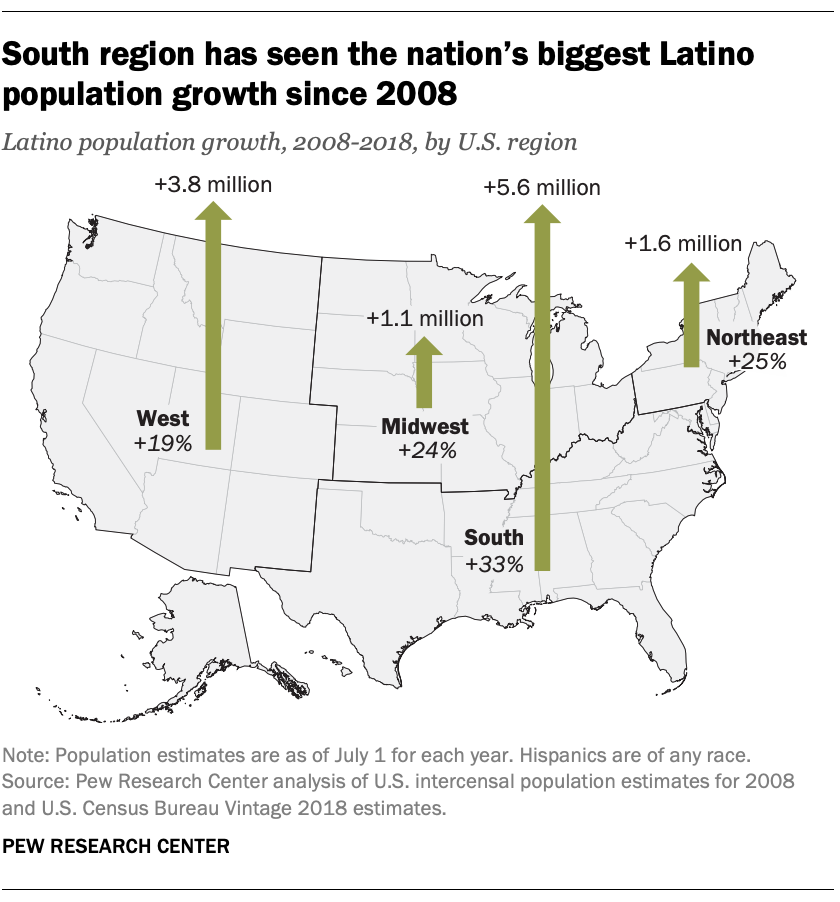 The South saw the fastest Latino population growth of anyU.S. region. The Latino population in the South grew 33% during this period, reaching 22.7 million in 2018, up 5.6 million from 2008. This growth was part of a broader increase in the Latino population in regions across the country since the 1990s. States in the Northeast (25% increase), Midwest (24%) and West (19%) also experienced growth in the number of Latinos from 2008 to 2018.
The South saw the fastest Latino population growth of anyU.S. region. The Latino population in the South grew 33% during this period, reaching 22.7 million in 2018, up 5.6 million from 2008. This growth was part of a broader increase in the Latino population in regions across the country since the 1990s. States in the Northeast (25% increase), Midwest (24%) and West (19%) also experienced growth in the number of Latinos from 2008 to 2018.
 The South saw the fastest Latino population growth of anyU.S. region. The Latino population in the South grew 33% during this period, reaching 22.7 million in 2018, up 5.6 million from 2008. This growth was part of a broader increase in the Latino population in regions across the country since the 1990s. States in the Northeast (25% increase), Midwest (24%) and West (19%) also experienced growth in the number of Latinos from 2008 to 2018.
The South saw the fastest Latino population growth of anyU.S. region. The Latino population in the South grew 33% during this period, reaching 22.7 million in 2018, up 5.6 million from 2008. This growth was part of a broader increase in the Latino population in regions across the country since the 1990s. States in the Northeast (25% increase), Midwest (24%) and West (19%) also experienced growth in the number of Latinos from 2008 to 2018.
3The states with the fastest Hispanic population growth tend to have relatively small Hispanic populations – and are not in the South. North Dakota’s Hispanic population grew by 135% between 2008 and 2018 – from 12,600 to 29,500, the fastest growth rate of any state. However, the state ranked 49th among the 50 states and the District of Columbia in its overall Hispanic population in 2018. Hispanic populations in South Dakota (75%), the District of Columbia (57%), Montana (55%) and New Hampshire (50%) also experienced rapid growth during this period, though all have relatively small Hispanic populations.
4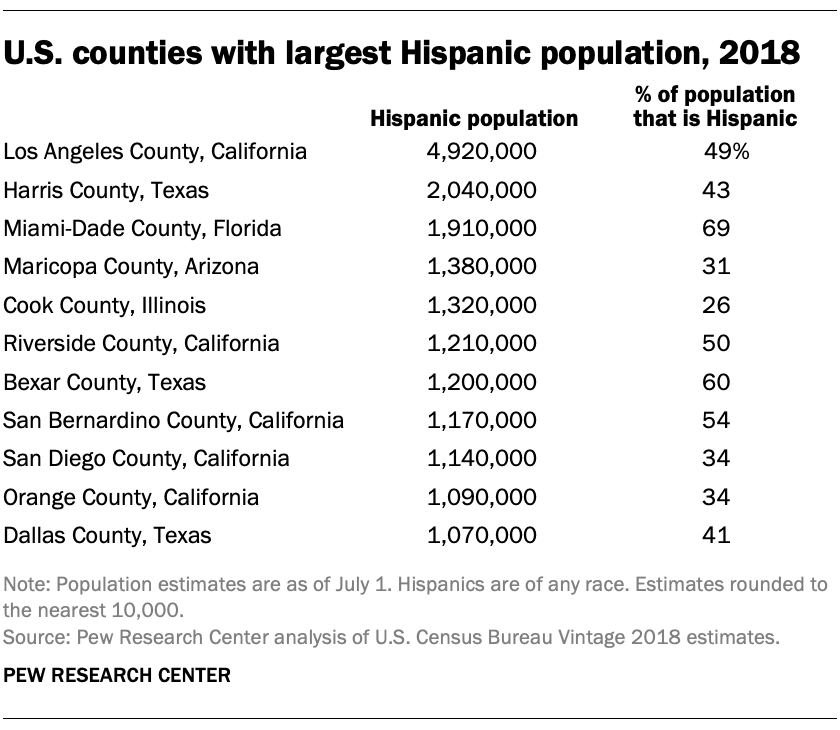 Los Angeles County had more Hispanics than any other U.S. county, with 4.9 million in 2018. The next largest were Harris County, Texas (2.0 million), and Miami-Dade County, Florida (1.9 million). Overall, 11 counties had more than a million Hispanics in 2018; these include Maricopa County, Arizona; Cook County, Illinois; and Riverside County, California. In 102 U.S. counties, Hispanics made up at least 50% of the population in 2018.
Los Angeles County had more Hispanics than any other U.S. county, with 4.9 million in 2018. The next largest were Harris County, Texas (2.0 million), and Miami-Dade County, Florida (1.9 million). Overall, 11 counties had more than a million Hispanics in 2018; these include Maricopa County, Arizona; Cook County, Illinois; and Riverside County, California. In 102 U.S. counties, Hispanics made up at least 50% of the population in 2018.
 Los Angeles County had more Hispanics than any other U.S. county, with 4.9 million in 2018. The next largest were Harris County, Texas (2.0 million), and Miami-Dade County, Florida (1.9 million). Overall, 11 counties had more than a million Hispanics in 2018; these include Maricopa County, Arizona; Cook County, Illinois; and Riverside County, California. In 102 U.S. counties, Hispanics made up at least 50% of the population in 2018.
Los Angeles County had more Hispanics than any other U.S. county, with 4.9 million in 2018. The next largest were Harris County, Texas (2.0 million), and Miami-Dade County, Florida (1.9 million). Overall, 11 counties had more than a million Hispanics in 2018; these include Maricopa County, Arizona; Cook County, Illinois; and Riverside County, California. In 102 U.S. counties, Hispanics made up at least 50% of the population in 2018.
5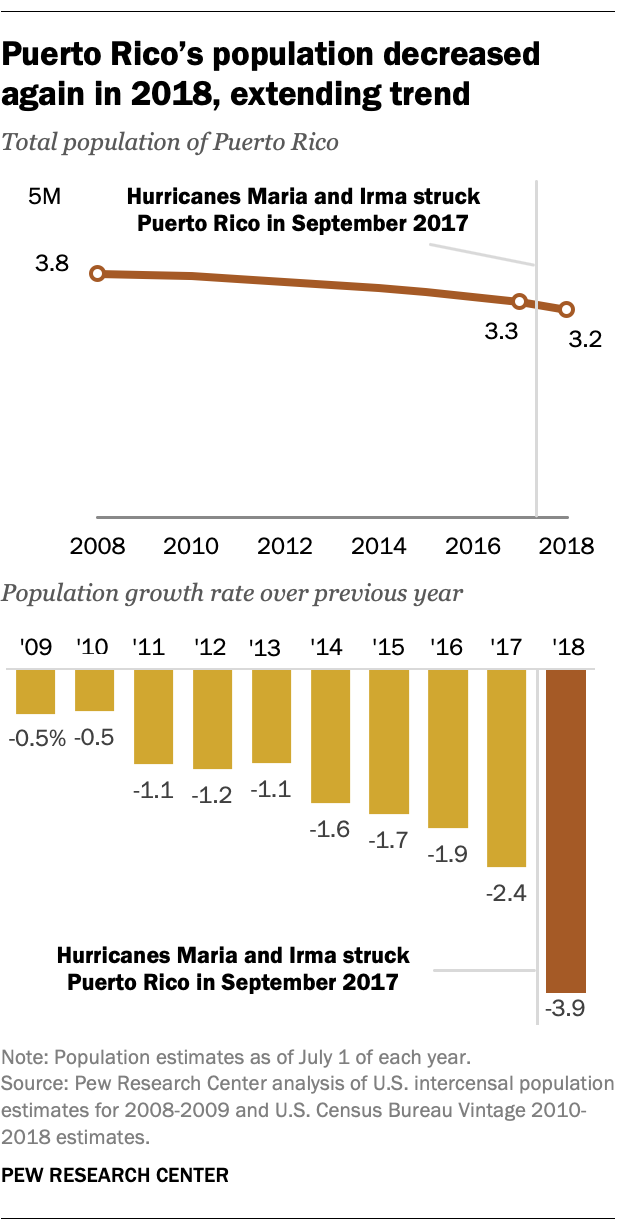 Puerto Rico’s population declined nearly 4% in 2018 and is down about 15% since 2008. The island’s population stood at 3.2 million in 2018, down from 3.3 million in 2017, when hurricanes Maria and Irma hit. The two disasters led many Puerto Ricans to leave for the U.S. mainland, especially Florida. Even before the hurricanes, however, the island’s population had experienced a steady, long-term population decline due to a long-standing economic recession.
Puerto Rico’s population declined nearly 4% in 2018 and is down about 15% since 2008. The island’s population stood at 3.2 million in 2018, down from 3.3 million in 2017, when hurricanes Maria and Irma hit. The two disasters led many Puerto Ricans to leave for the U.S. mainland, especially Florida. Even before the hurricanes, however, the island’s population had experienced a steady, long-term population decline due to a long-standing economic recession.
 Puerto Rico’s population declined nearly 4% in 2018 and is down about 15% since 2008. The island’s population stood at 3.2 million in 2018, down from 3.3 million in 2017, when hurricanes Maria and Irma hit. The two disasters led many Puerto Ricans to leave for the U.S. mainland, especially Florida. Even before the hurricanes, however, the island’s population had experienced a steady, long-term population decline due to a long-standing economic recession.
Puerto Rico’s population declined nearly 4% in 2018 and is down about 15% since 2008. The island’s population stood at 3.2 million in 2018, down from 3.3 million in 2017, when hurricanes Maria and Irma hit. The two disasters led many Puerto Ricans to leave for the U.S. mainland, especially Florida. Even before the hurricanes, however, the island’s population had experienced a steady, long-term population decline due to a long-standing economic recession.
6Latinos are among the youngest racial or ethnic groups in the U.S. but saw one of the largest increases in median age over the past decade.Latinos had a median age of 30 in 2018, up from 27 in 2008. Whites had the highest median age nationally – 44 in 2018 – followed by Asians (37) and blacks (34). The median age for both Latinos and whites has increased by three years since 2008, tying for the largest uptick of any racial or ethnic group.
No comments:
Post a Comment